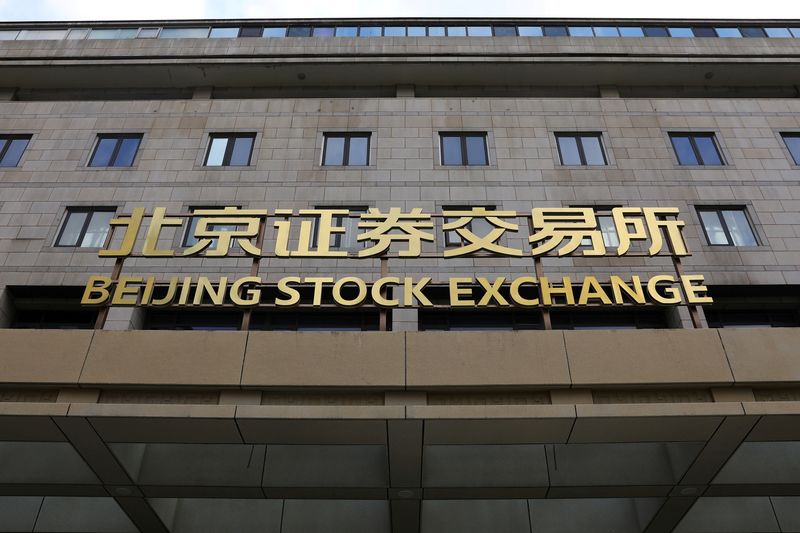Global shares, US stocks turn lower; oil prices gain
By Chris Prentice and Amanda Cooper
NEW YORK/LONDON (Reuters) -Global shares turned lower on Monday as traders focused on inflation data and chip stocks fell, while Beijing's promise of stimulus lifted oil and gold prices.
U.S. inflation data this week could cement a December rate cut. China's decision on Monday to alter the wording of its stance towards monetary policy for the first time since 2010 helped global sentiment. Beijing pledged to introduce stimulus to encourage economic growth next year.
The rapid collapse over the weekend of Syrian President Bashar al-Assad's 24-year rule complicates an already fraught situation in the Middle East.
Oil and gold prices rose.
In France, President Emmanuel Macron had yet to name a new prime minister after Michel Barnier's minority government collapsed last week over his austere budget.
Friday's U.S. monthly employment data was strong enough to soothe any concerns about the resilience of the economy, but not so robust as to rule out a rate cut from the Federal Reserve next week.
MSCI's gauge of stocks across the globe fell 1.67 points, or 0.19%, to 872.06.
The Dow Jones Industrial Average fell 85.44 points, or 0.19%, to 44,559.65, the S&P 500 fell 27.93 points, or 0.46%, to 6,062.34 and the Nasdaq Composite fell 108.40 points, or 0.55%, to 19,751.38.
"In addition to being reminded that December is positive 'close to three-fourths of the time,' we have seen record equity inflows, full positioning from asset managers and the highest ever reading from the Conference Board’s survey of retail investor expectations," Morgan Stanley (NYSE:MS )'s chief investment officer Lisa Shalett said in a morning note.
"Complacency indicators are flashing, however, and while we appreciate technicals’ short-term validity, we encourage long-term investors to be measured in their enthusiasm."
HEAVY WEEK FOR CENTRAL BANKS
November's payrolls report showed 227,000 jobs were created last month, compared with expectations for a rise of 200,000, while October's hurricane-distorted number was revised up.
Markets now imply an 85% chance of a quarter-point cut at the Fed's Dec. 17-18 meeting, up from 68% ahead of the jobs figures, and have a further three cuts priced in for next year.
The next test is Wednesday's U.S. inflation report.
The dollar index , which measures the greenback against a basket of currencies including the yen and the euro,fell 0.12% to 105.82, with the euro up 0.21% at $1.059.
The European Central Bank is widely expected to deliver a quarter-point cut on Thursday.
In Asian markets, Chinese stocks and bonds rallied after China's Politburo was quoted as saying that the country will adopt an "appropriately loose" monetary policy next year, rather than a "prudent" one, marking the first time it has changed the wording of its stance in around 14 years.
Beijing said it would introduce an array of measures geared towards boosting domestic demand in 2025. The central bank has outlined five policy stances - "loose", "appropriately loose", "prudent", "appropriately tight" and "tight" - with flexibility on either side of each.
South Korean stocks slid 2.8%, while the won currency weakened against the dollar by 0.6%, even as authorities pledged all-out efforts to stabilise financial markets amid uncertainty over the fate of President Yoon Suk Yeol.
This week is full of central bank meetings, aside from the ECB's. The Swiss National Bank could cut rates by as much as half a point given slowing inflation, as could Canada's central bank when it meets on Wednesday.
The Reserve Bank of Australia meets on Tuesday and is one of the central banks expected to hold fire, while Brazil's central bank is set to hike again to contain inflation.
"With geopolitical uncertainty high and conflicting signals from hard and soft data, monetary policy remains the only game in town to support economic activity, especially in the absence of strong political leadership in Paris and Berlin," said Barclays (LON:BARC ) economist Christian Keller.
Geopolitical uncertainty helped gold
U.S. crude rose 2.16% to $68.64 a barrel and Brent rose to $72.43 per barrel, up 1.81% on the day.
Source: Investing.com
